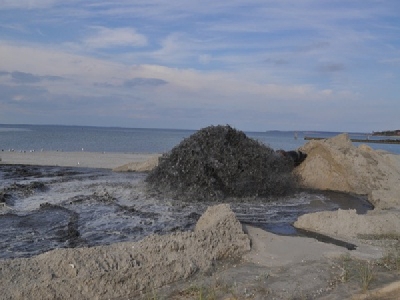
Posted on August 1, 2016
By Chau Lam, Newsday
The U.S. Environmental Protection Agency will continue to allow the disposal of dredged soil and sediment at two open-water sites in Long Island Sound over the next three decades, and the department will select a third location this fall — decisions decried by local environmentalists and politicians.
Sludge pulled from the bottom of rivers, lakes and harbors can contain mercury, lead and pesticides, and is harmful to marine life, said critics, who had urged federal officials to repurpose the material and put it to use.
“I am disappointed to say the least. They lack imagination,” said Assemb. Steven Englebright (D-Setauket), who chairs the chamber’s Environmental Conservation Committee. “The irony is that these same federal agencies are looking at sea level rise in the next 30 to 40 years, and rather than planning to use the sediment to defend our coastal communities, they’re just going to throw it away. It’s crazy.”
The two mid-Sound disposal sites — Western Long Island Sound and Central Long Island Sound — will reopen next month and begin accepting dredged spoils again.
Harbors and ports need to be dredged to allow boats, cargo ships and passenger liners to pass safely. The contentious question is where to put the muck, and the cost of different disposal methods.
Since the 1980s, dredged spoils have been dumped at four open-water disposal sites in the Sound — Western, Central, Cornfield Shoals and New London.
The U.S. Army Corps of Engineers, the federal agency overseeing 52 navigation projects — 31 in Connecticut, 17 in New York and four in Rhode Island — earlier this year released a plan, which estimated that dredging is expected to produce as much as 53 million cubic yards of sludge over the next three decades.
Of the anticipated 53 million cubic yards of dredged spoils, 65 percent is expected to be fine-grained materials the Army Corps said is “suitable” to be dumped into the Sound. About 29 percent is expected to be sand, which could be used to shore up beaches. The remaining 6 percent is anticipated to be toxic for open-water disposal and is expected to be sent to hazardous landfills.
The EPA, which governs ocean dumping, on July 7 officially gave the Army Corps permission to use Western and Central as disposal sites, with certain conditions attached. Among them is establishing a steering committee charged with working toward reducing open-water disposal and developing ways to re-use the sludge, such as restoring wetlands and capping landfills.
Critics, however, said the yet-to-be-formed committee is an advisory body that has no power.
“What is a committee going to say down the road? Halt the dredging? That’s not realistic,” said Scott Russell, supervisor of the Town of Southold. “Monitor is another word for lack of action.”
Adrienne Esposito, executive director of Citizens Campaign for the Environment, an advocacy group based in Farmingdale, had hoped that the EPA would have set concrete reductions.
“It would have been stronger had a numerical goal been established,” Esposito said. “But it does establish an avenue for accountability for all the agencies, something we didn’t have before.”
Meanwhile, permits on the Cornfield Shoals and New London locations are scheduled to expire on Dec. 23, and the EPA is selecting the third disposal site. These two and Niantic Bay are under consideration, but federal officials will likely reject Cornfield Shoals because dredged spoils dumped here would eventually spread to other areas of the Sound, said Mel Cote Jr., an official in the EPA’s New England office. And, portions of sludge at the Niantic Bay may be moved around by future storms.
The EPA is proposing to set aside an area off Fishers Island, about 2 nautical miles large, to create the third disposal location called the Eastern Long Island Sound Disposal Site, Cote said. Eastern, the EPA’s preferred location, would be made up of roughly half of the New London site (the western half), and an adjacent portion.
The EPA is reviewing public comments regarding the selection of the third site, and Cote said a decision is expected in the fall.
Source: Newsday





